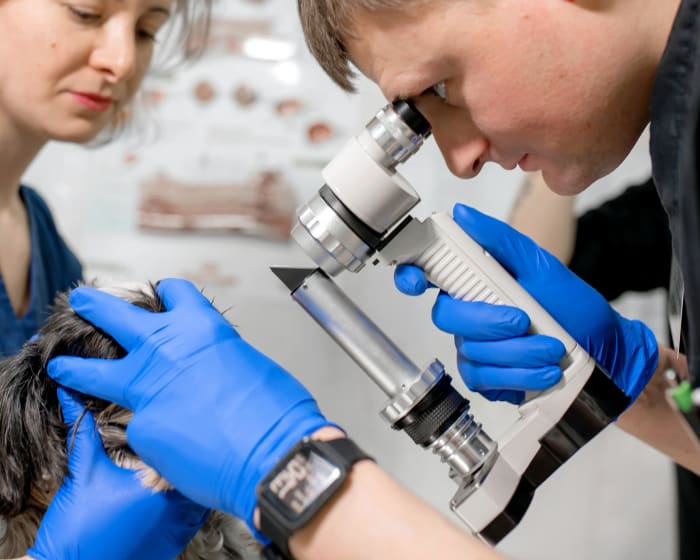Full Veterinary Ophthalmology Diagnostics in Vancouver
At Columbia River Veterinary Specialists, we are fully equipped to conduct eye examinations and animal eye surgery.
We can also use two types of instruments to measure the indirect blood pressure of our patients, either suspected as being hypertensive or for anesthesia monitoring.

Our Ophthalmology Diagnostic Equipment
We are pleased to offer advanced diagnostic testing at our in-house veterinary diagnostics lab. This allows our vets to offer an accurate diagnosis of your pet's ocular issues.
- Slit-lamp Biomicroscopes
A slit lamp is a microscope with a bright light used during an eye exam. It gives our veterinary ophthalmologists a closer look at the different structures at the front of your pet's eye and inside the eye. It’s a key tool in determining the health of your eyes and detecting eye disease.
- Binocular Indirect Ophthalmoscopes
Indirect ophthalmoscopy is done by ophthalmologists and optometrists to examine the retina as well as the optic nerve, vessels, and macula lutea. The entire fundus or back of the eye can be seen with this instrument.
- CO2 Laser
Our CO2 laser allows for removal of some eyelid tumors without the need for general anesthesia. This is particularly advantageous for elderly pets.
- Direct Ophthalmoscope
A direct ophthalmoscope, or simply an ophthalmoscope, is a hand-held optical instrument used to inspect the fundus or back of the eye.
The ophthalmoscope contains a handle with a rechargeable battery and a detachable head that contains a bulb, a light source, and a set of lenses. The view provided by the ophthalmoscope is monocular and is magnified about 15 times.
- Gonioscopic Lenses
Gonioscopy is performed during the eye exam to evaluate the internal drainage system of the eye, also referred to as the anterior chamber angle. The "angle" is where the cornea and the iris meet. This is the location where fluid inside the eye drains out of the eye and into the venous system.
Under normal circumstances, the angle cannot be seen on exam. A special contact lens prism placed on the surface of the eye allows visualization of the angle and drainage system.
- Computerized Electroretinographic (ERG) Equipment
This is an eye test that detects the function of the retina (the light-detecting portion of the eye). Specifically, the ERG picks up electrical signals from photoreceptors and other cells. Abnormal ERG readings can detect certain abnormalities of these cells. During the test, your vet will place an electrode on the front of the eye to measure the electrical responses to light of these cells.
- Nitrous Oxide Cryosurgical Unit
A nitrous oxide cryosurgical unit for treatment of tumors and extraction of dislocated lenses.
- Ocular Ultrasound Machine
An ocular ultrasound uses high-frequency sound waves to measure and produce detailed images of your pet's eye and eye orbit (the socket in your skull that holds your pet's eye). This test provides a much more detailed view of the inside of your animal's eye when visualization inside the eye is limited by things such as cataracts or bleeding.
- Zeiss Operating Microscope
When your vet can see more they can make better decisions during retina, cataract, glaucoma, and corneal surgeries. ZEISS ophthalmic microscopes provide an outstanding visualization of the eye, with excellent ergonomics and integrated assistance functions.
- Phacoemulsification Unit
Our brand new phacoemulsification unit allows cataract removal through a small incision. Intraocular lenses are used to provide optimal vision after surgical removal of the lens.
- RetinoGraphics PLR Tester
Our RetinoGraphics chromatic pupillary light response tester helps with the evaluation of retinal function in dogs. Most commonly, this machine is used to lend support to a diagnosis of sudden acquired retinal degeneration syndrome, although ERG remains the gold standard test.
- Tono-Pen
The Tono-Pen measures intraocular pressure and is designed to help eliminate operator error and functions in any position, making it ideal to use on all breeds of animals. Activated by the push of a button, the intraocular pressure measurement is displayed on two large, easy-to-read, LCD screens and can be used by right or left-handed users.
- TonoVet Tonometers
The use of tonometry to measure Intraocular Pressure (IOP) is for screening of glaucoma in veterinary patients. It utilizes a new technology called “rebound” tonometry. At the push of a button, a tiny probe painlessly and rapidly reaches out and touches the cornea. Six rapid measurements are successively taken within seconds.
It can be used on all veterinary patients including horses, it's self-calibrating with its own software, it is easy to use and fully automated, and it provides faster results.
General Anesthesia
We make every effort to make general anesthesia as safe as possible. Our comprehensive set of anesthetic monitors helps to achieve this goal.
Our monitors consist of a pulse oximeter, electrocardiograph (ECG), end-tidal CO2 monitor, blood pressure unit, and a nerve stimulator. Only isoflurane or sevoflurane gases are used. A ventilator is available to ensure the adequacy of respirations in our anesthetized patients.
